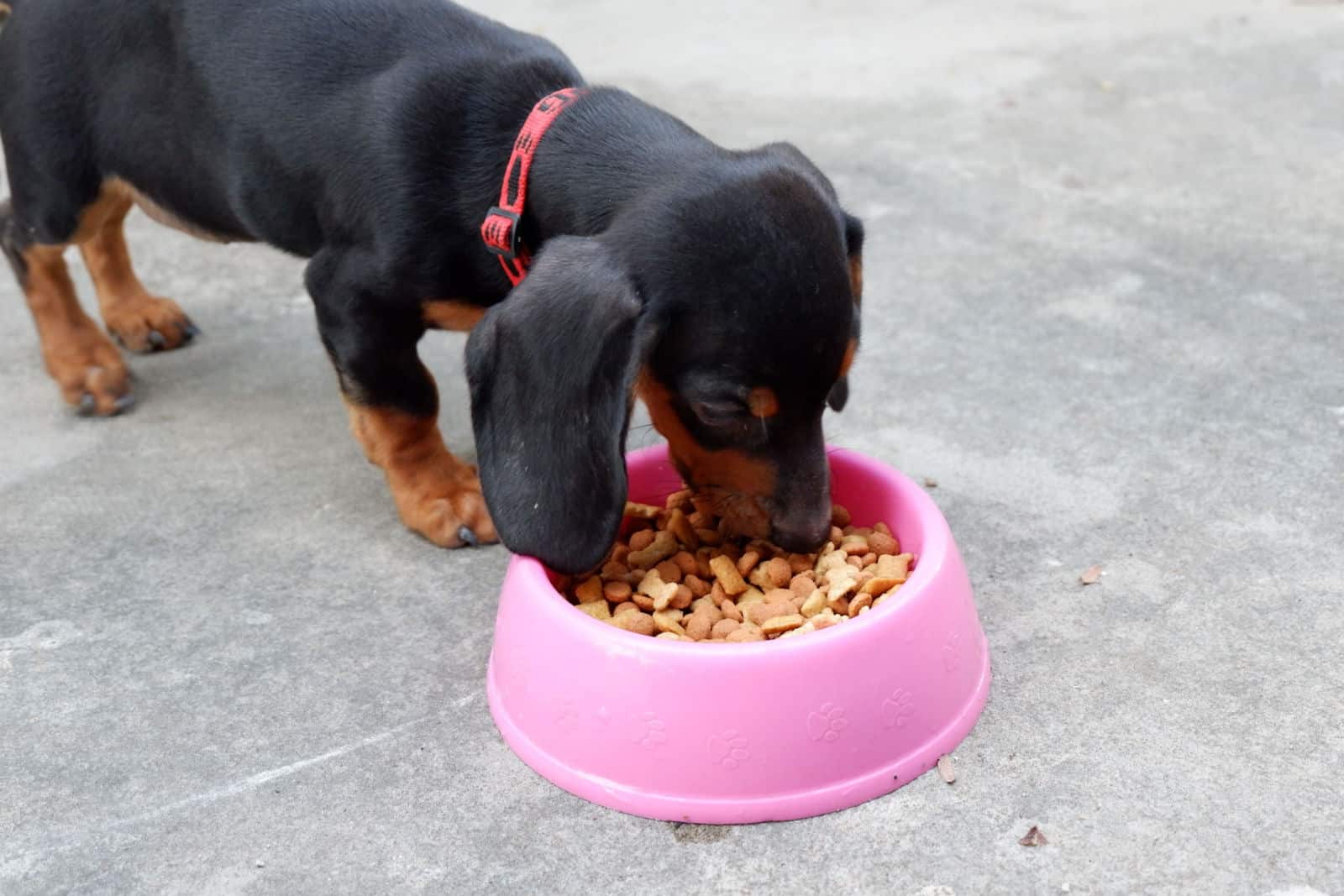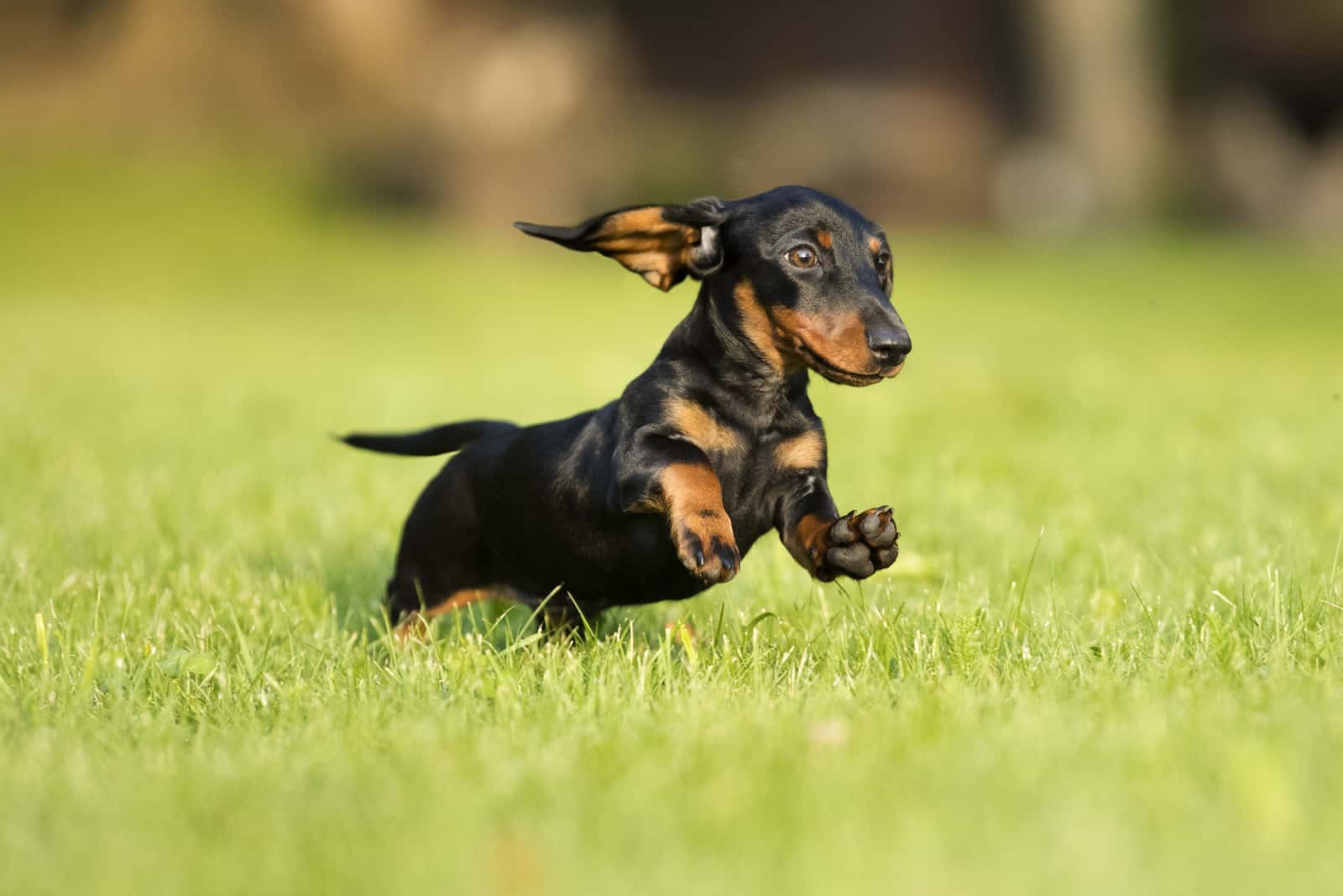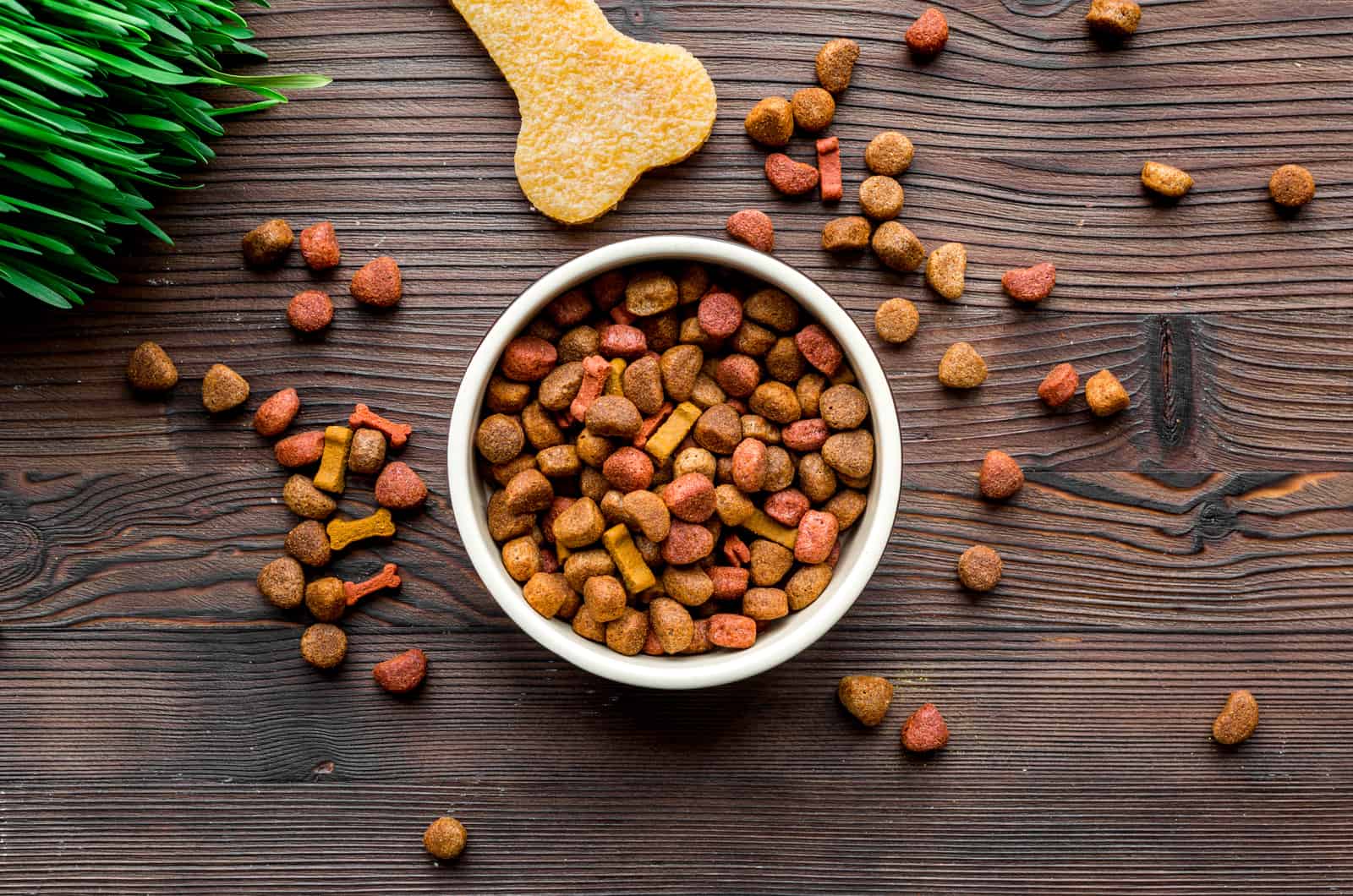The wiener dog, also known as the Dachshund, is one of the most energetic small dogs out there, but what do they eat to keep their stamina up? That’s what the Dachshund feeding chart is here to uncover.
The Dachshund feeding chart helps us see how much an average member of the Dachshund family is meant to weigh and eat.
While they’re mostly estimates drawn out from gathered information, they’re the best thing we have to note what a healthy weight would be for the average Dachshund.
Naturally, there are a few factors that can skew this on an individual basis, but should that be the case, it’s best to seek advice from your local vet or certified pet nutritionist.
That said, keeping a Dachshund fit isn’t going to be the biggest issue given their high energy levels, but it’s still important to know what you need to feed him and how much.
After all, they’re still a small dog breed and a few extra pounds for them is a lot more than the same amount on a medium or large breed of dog.
If you want to find out what this chart looks like as well as how that progresses throughout all of your dear doggo’s life stages, what influences it as well as the many questions often asked regarding a Dachshund’s diet, be sure to read on.
The Dachshund Feeding Chart

Also known as a weight chart or a partial growth chart, here’s what an average Doxie ends up looking like.
| Age | Miniature Dachshund Weight | Standard Dachshund Weight | Daily Intake Portion | Portion |
|---|---|---|---|---|
| 3 months | 5.5 – 7.1 lbs | 13 lbs | 7 – 15 oz | 4 |
| 4 months | 7.5 – 9.5 lbs | 18 lbs | 7 – 15 oz | 3 |
| 5 months | 9.5 – 11.5 lbs | 22 lbs | 7 – 16 oz | 3 |
| 6 months | 11 – 12.8 lbs | 25 lbs | 7 – 16 oz | 3 |
| 7 months | 12.5 – 14 lbs | 27 lbs | 6 – 12 oz | 2 |
| 8 months | 13.8 – 14.9 lbs | 29 lbs | 6 – 12 oz | 2 |
| 9 months | 14.5 – 15 lbs | 30 lbs | 5 – 11 oz | 2 |
| 10 months | 14.9 – 15.7 lbs | 31 lbs | 5 – 11 oz | 2 |
| 11 months | 15.5 – 16 lbs | 32 lbs | 4 – 11 oz | 2 |
| 12 months | 16 lbs | 32,5 lbs | 4 – 11 oz | 2 |
From the Dachshund feeding chart we can actually see a rather odd, but fascinating phenomenon, the fact that the Doxie’s daily intake lowers as he ages.
This is due to their inherent size and the fact that their body doesn’t require a lot of food to properly function.
The initial daily food intake is to help the growth process along and to literally put some meat on those doggy bones, but as the dog gets closer to his adult weight, He won’t need that amount of food anymore so you get to reduce it.
This is an extremely important thing to note as obesity is one of the biggest health problems surrounding food for smaller dogs.
A pound extra for them, once again, is going to have a bigger effect on their life and overall health than it would on a large dog breed for instance and can shorten their lifespan.
That’s why finding out what the right amount of food and the proper number of meals for your Dachshund is on a daily basis is incredibly important as it will drastically improve his quality of life.
Speaking of which, the number of portions also reduces as they age as they’ll need more food in one go to keep them active rather than lethargic as bigger bodies require more “fuel” to function.
That said, portion sizes can be played with somewhat and can be increased by a number, as long as the daily calorie intake remains the same.
This does depend from dog to dog, but more, and smaller portions also help teach your dog how to pace himself in order to reduce the potential risk of bloat later down the line.
This may still seem a little confusing for some, so here’s a small Dachshund feeding guide throughout the course of their life.
Dachshund Diet Over The Years

0-2 Weeks Of Age
The initial stages of a Doxie’s life, be they a mini Dachshund or a standard one, are almost always going to be taken care of by the breeder, and such is the case here, albeit with one slight difference.
The first two weeks of life are normally taken care of by the mother as the pups are too young to be going off on their own and the main type of food that they’ll be consuming during this period is going to be mother’s milk.
If you are said breeder, do make sure to make minimal contact with the pups so your scent doesn’t rub off on them as their mother may reject them for it, after which you’ll have to take over care for the affected ones.
A heating pad mixed together with a mother’s milk replacement to feed them with and simulate the care of a mother is ideal.
There’s also the option of covering the pad with something of a texture similar to that of their mother’s fur, as well as an old-timey ticking clock to replicate her heartbeat to replicate the experience to its fullest extent.
3-4 Weeks Of Age
This period is when the pups grow a little and are capable of going around on their own.
Most are likely to still be on mother’s milk, but by the tail end of this period, it’s recommended to give your first attempt at weaning them off it and putting them on solid foods.
Plenty of water is usually needed too, especially if you’re planning on making the swap as sudden changes are often rejected. Food needs to be introduced gradually.
The most common trick used is one that takes 3 parts water, 1 part dry dog food to slowly get the dog adjusted to the texture of the food, gradually shifting the ratios to favor the kibble until all the water is out of the equation.
It won’t work with some and you should keep trying every week until successful, you only have until week 8 to get them off the mother’s milk after all.
5-8 Weeks Of Age

This is the period where the Doxie is likely to exhibit his biggest growth spurt and is most likely to be his biggest consumption period.
However, I didn’t include it on the chart because some Dachshund puppies may still be on mother’s milk.
This is the final period where you can wean them off of it, otherwise they may not be fit to be rehomed yet.
It’s also the period where you’ll need to give them some basic behavioral training if you’re looking to improve the dog’s quality.
Sure they’re small, but they can be troublesome, and the younger they are, the better the training sticks.
2-3 Months Of Age
The period where the dog owners take over. By now the dog should be on puppy dog food, but you may still need to give them some milk on the side, though water should be more than fine.
Other than concerning yourself about their meals, you’ll need to be wary to continue their behavior training.
The ideal number of portions at this stage in regards to the dog’s food should be around 4 with varying portion sizes depending on if you’re dealing with a mini or standard Dachshund.
4-6 Months Of Age

This period represents one of the Dachshund’s last major growth spurts which will be the last time their daily food intake will increase, albeit not by much.
Also, the number of portions decreases to 3 as bigger dogs need more food in one sitting to get their energy up.
Other than that, not much changes, just be sure to keep up with his daily walks and exercises so the weight can be evenly distributed and your dog can stay in shape.
7-8 Months Of Age
This is the first period where we see a drastic reduction in required daily nutrition as, by the end of this period, the pup is considered to be of adult size, though some dogs may take a few months longer.
You won’t be seeing many more growth spurts after this, if at all, which is why the Doxie won’t need as much food anymore, only enough to maintain his current weight.
The portion amount also decreases to 2 on average and is likely to stay that way until his senior years.
9-12 Months Of Age

The last remaining period of the dog’s official puppy period before transitioning into a full blown adult dog.
The amount of food needed daily reduces further though the portion sizes remain the same.
There’s no further growth to note, maybe an inch or two at most, but most Doxies generally retain the height achieved by month 8 and there aren’t any other drastic changes that are going to be happening.
The only thing to note is that you may want to start transitioning him away from puppy dog food over to one that caters more to adult dogs.
Much like with actual kids, the most tumultuous period happens in that first year, after which things cool down a bit.
1-11 Years Of Age
This is the official adult period of a Dachshund. It’s a lot longer than that of many other dog breeds because Doxies tend to have a relatively long lifespan given their short stature and overall healthy lifestyle.
If you haven’t swapped your dog to adult kibble yet, now would be the right time to do so as they won’t need as much protein as they would’ve when they were still growing.
The adult diet offers them more nutrients per ounce without the need to put on extra pounds.
As your dog gets closer to his senior years, his metabolism is going to start winding down and you may need to reduce his daily food intake, the amount of which varies, but is easy to pinpoint through trial and error.
That said, consulting a certified pet nutritionist or a veterinarian is arguably the best as they may give you better input since they have access to your dog’s health records.
12 Years Of Age And Onward
Once your dog reaches his senior years, you’ll likely be going down to fewer calories, 9-10 ounces of high quality dry dog food daily maximum, but even that varies depending on your dog’s health.
Though, some may require a swap to dog food that’s better fit for senior dogs, softer and easier to digest to accommodate a slower metabolism.
Aside from that, make sure he gets his exercise in to keep him healthy and the rest should go along as normal.
What Major Factors Impact A Dachshund’s Weight?

Much like with any other dog, three major factors are the biggest influences in a dog’s weight gain and retention.
They can be both positive or negative depending on how they’re treated and some can be influenced while others are simply there since birth.
They aren’t the only ones, mind you, but they certainly are the biggest ones.
They are the following:
1. Genetics
Genes determine the effectiveness of almost every aspect of a living being’s body, that includes dogs.
What color their fur is, how well it grows, their own overall proportions and the speed of their metabolism among other things.
It also determines how healthy they are in general and whether or not they’re more prone to some specific health issues.
The metabolism and the health part are of interest in terms of weight as the former is responsible for how much food your dog can ingest daily without packing the extra pounds while the latter can also shift that balance out of whack.
Various things can cause either malnutrition or obesity, changing the caloric intake that the Dachshund needs daily, but more on that later when we cover the specific health problems.
The problem comes from the fact that genes are pretty much set and there isn’t much we can do to alter them, we can only face the problems they may cause when they arrive and hope that the problems themselves are treatable at the very least.
One of the example problems would be food allergies, where your dog will have to adjust to a whole different diet just because his digestive system can’t process a specific food item.
2. What He Eats

Speaking of food, the next major factor relates to the Dachshund’s diet itself.
While things change from what a Dachshund puppy eats to what an adult one does, the nutrients mostly stay the same as do the other components with a bit of a ratio shift.
The biggest change is in the amount of food consumed on a daily basis, which, in the Dachshund’s case, reduces from month 3 onward.
This is primarily due to the fact that he’s a small breed where one needs to be careful not to overfeed the dog so he doesn’t become obese, as that poses serious health risks for smaller dogs in particular.
Given how different forms of kibble have differing calorie counts in the same amounts, it’s hard to really pinpoint the right amount of food needed in a day, which is why I keep saying that you’ll need to adjust yourself.
The Dachshund feeding chart is only there to serve as a starting point while the final metric is something you yourself need to reach.
The food you may be feeding your furry friend is likely to be entirely different from the control food used in this case.
Not to mention, puppy food differs in calories compared to adult or senior dog food, which is another factor that you need to keep in mind for the transitory life stages of a Dachshund’s lifespan.
Though calories aren’t the only thing you should be worried about, nutrients are too, as mentioned prior, and here are some of the most important ones to have in your dog’s kibble.
Not all of them are needed, but the more boxes you can tick, the better.
Quality Protein
A good protein is the foundation of every piece of dog food, and chicken and beef tend to be the best ones to go for with the other alternatives being that of turkey, lamb or fish.
Fiber
Something to make all that protein go down smoother is always good to have paired with it, a source of fiber, be it rice, sweet potatoes, peas or similar.
A Healthy Protein To Fat Ratio
You’ll also want around a 18% protein and 5% fat ratio in his food ideally, though you can deviate on this one as long as the ratios remain relatively similar.
Make sure to avoid fillers as they’re often just empty calories as well as some common allergens like corn, soy and wheat in your dog’s food if he’s having sensitivity issues.
Omega 3 Fatty Acids
Other than that, you’ll want to make sure that the food contains omega-3 and 6 fatty acids which help keep your dog’s fur nice and shiny and improve your dog’s overall immune system.
Probiotics
Speaking of which, a healthy batch of probiotics and prebiotic fiber is always welcome as it helps foster the growth of healthy gut bacteria which are responsible for digestion and a more responsive and healthier immune system.
Aside from that, you’ll want a healthy dose of vitamins in there, as per usual, to help with overall growth.
DHA and EPA
DHA and EPA are particularly important in puppies as they help develop and maintain their cognitive skills.
Calcium And Phosphorus
Calcium and phosphorus are important too as they help with proper bone and cartilage growth.
Glucosamine And Chondroitin
Aside from those, you also want to include some chondroitin and glucosamine which help maintain bone and joint health.
While not as important for smaller dogs as they are for medium and large dog breeds, they’re still nice to include to prevent general bone related health issues in your Dachshund’s senior years.
3. His Level Of Exercise

Last, but not least in terms of major contributing factors would be the dog’s activity level.
As with any other living being, getting some physical exercise in is going to help melt those pounds and build some muscle, and dogs need to do it regularly to maintain their physique.
Thankfully, the Dachshund isn’t all too demanding, needing only around 50 minutes of light to moderate exercise to sate his needs, albeit in several intervals rather than in one long burst given their shorter build and lack of stamina.
Their energy levels are relatively decent, but their legs weren’t made for long stretches of exercise, so do keep that in mind.
How Big Does A Dachshund Get?

Pinpointing the exact size of a Dachshund can be a daunting task as they have 2( or 3, depending on who you ask) different sizes to them.
The two listed above are standard and miniature with the standard Doxies usually coming in anywhere between 16 to 32 pounds in terms of weight.
Their height differs between male and female Dachshunds with the former coming in at around 16 to 18 inches while the latter ends up somewhere around 15 to 17. Not the biggest difference, but it is there.
Miniature Dachshunds, on the other hand, are ones that are 12 pounds and below, with their height coming in at around 14-ish inches for male specimens and 13 for female ones.
The third ones, which are often called Rabbit Doxies or Kaninchen, are similar to the miniature ones, but smaller in stature, with their weight fluctuating between 8 and 11 pounds.
Though, their height is the difference maker as the Kaninchen males come out to around 12 or so inches in height while the females sport a mere 10 to 11 inches.
This makes them appear slightly chubbier than the miniatures, but they’re still considered to be healthy nonetheless.
SEE ALSO: Dachshund Growth Chart: What Size Will Your Pup Reach?
FAQs

This question gets asked quite often, but my answer remains the same, dry dog food is better in most cases.
Sure, the dogs love wet food more, but everything good usually has plenty of drawbacks hidden behind it.
Namely, the wet dog food tends to stain teeth and is overall bad for dental health on top of being pricy.
Sure, it has a lot more flavor to it and offers more variety, but it’s best used every now and then to keep your dog’s teeth in good shape as they’re one of their main tools.
Said tools are mostly maintained by the very kibble that is recommended as it helps clean the teeth while being chewed and still providing more nutrition than the wet option normally would.
On top of that, it’s a lot more affordable as one meal of wet dog food may ring you up just as much as a whole bag of kibble, if not more, depending on the brand.
Ultimately, dry dog food is better for your pockets and for your dog’s teeth, but indulging in wet dog food every now and then can be beneficial.
Alternatively, if you want to turn dry dog food into wet without adding too much of a price tag to it or any more calories, using bone broth and pouring it over the kibble is a good and healthy alternative.
RELATED: 12 Best Dog Foods For Dachshunds (Top Products Reviewed)
That one is a matter of perspective.
Raw food has its uses, the customizability of it all on top of helping eliminate carbs from diets to make digestion easier for the dog are good positives, however they neglect to mention the negatives of it all too, the two main ones being time and money.
It takes a lot of time to find the necessary ingredients, especially when one needs to try and strike a nutritional balance in the raw diet, something which is often lacking and ends up leaving your dear doggo in a deficit.
Dog food doesn’t end up having that issue as the nutrients are all neatly packed in there and they’re usually all accounted for.
On top of all that, there’s the cost of the material to be considered, which can amount to a lot, especially if you’re going for some specific stuff.
And, of course, time and money are both precious resources which, if you can spare, then the raw option may be a decent alternative for your doggo.
That said, there’s also one more factor and that’s the fact that raw meat is more prone to making your dog sick or giving him some sort of parasite unless cooked properly.
Regardless, it’s not something I want to risk any of my dogs contracting, but this is ultimately your choice.
As with many other important food related decisions, I’d consult a pet nutritionist or a vet on the possible benefits and dangers regarding your canine companion.
Well, as you can see from the chart, that depends on his age.
Young pups that are barely 2, maybe 3 months old, are going to require 4 meals a day, spaced out evenly and of equal size.
They’re also the biggest amounts of food your dog will be eating in his lifetime, shrinking down as he gets older.
This is primarily to help them grow early and to get them to their proper size at the appropriate time.
Some people may mention free feeding, but it’s never a good practice to free feed puppies as it won’t help teach them to pace themselves with their food which may turn into a problem later down the line.
Once they reach month 4 and all the way up to month 6, the portion sizes tend to shrink down to 3 meals a day, but the amount of food they’ll be fed is still the same, just spaced out differently.
From month 7 and onward, the daily food consumption will drop as will the amount of daily portions, with the latter going down to 2 and staying there for most of his life while the food intake keeps on dropping as he grows older and his metabolism slows down.
Again though, all of these numbers are averages and your dog may differ from them ever so slightly.
The best method of determining how much your dog should be eating daily is going to be determined by you.
In order to help out with that a little, keep in mind that your dog will need a lot of energy at every point so keeping the meals equal in amount is important.
More portions isn’t always that bad either as lots of small meals can have a good effect too in helping teach your dogs to pace themselves, the opposite of free feeding that was mentioned prior.
And don’t forget to adjust properly when your dog swaps from puppy to adult Dachshund and from adult to senior as well, especially when you’re changing the type of food to better adhere to that life stage.
They have different caloric content and protein to fat ratios which will require different portioning, albeit not that drastically different.
You may not get it on the first go around, but you’ll get the hang of it through trial and error, as is the case with most things in dogs relating to quantity in general.
Well, it’s the most common ones really, ones that apply to every dog.
Avoid giving him table scraps. Sure, you may end up with some leftovers, or you may not like the particular dish of the day, but pretending like your dog is a trash can that you can shove all this food into isn’t going to do him any favors.
You’ll just end up overfeeding him and making him gain weight, especially considering how you can’t really figure out how much food you’re really giving him,
A bite here or there can be fine, but don’t make it into a habit as it’ll only be a detriment to your precious pooch. Stick to his proper feeding schedule instead so he can be kept close to his ideal weight if possible.
Don’t give him too many treats. Similar to the one above, you don’t want to go overboard with treats either, especially during training.
Not all food is dog friendly. One final bit of advice is that dogs have different digestive systems to our own and they can’t process the same food that we can.
There are particular ones which are incredibly dangerous to them and cause a variety of issues.
Chocolate is the obvious one due to theobromine which can cause irreparable damage to your canine companion.
Avocadoes, various nuts, garlic and onions are a big danger too, the former two due to gastric issues while the latter two can cause havoc on your dog’s red blood cells as well as irritate his intestines.
Finally, there are also some forms of peanut butter that are unsafe. The product itself can be fine as long as there’s no traces of Xylitol in it as it can cause liver failure in dogs if taken in large amounts so be sure to read the label carefully.
To be safe, it’s best to feed your dog some low calorie treats like watermelon when it’s in season or green beans and the like.
While there are several health issues that can affect Doxies, there are only a few that relate to food in particular.
The two main ones are bloat and parasitic worms, the former often being caused by overfeeding or a lack of pacing in the dog’s eating habits, when their stomach distends a lot and ends up twisting into itself after contracting.
This ends up cutting blood flow to surrounding organs and traps the contents of the stomach, causing major problems which are thankfully reversible, but require immediate medical attention before they do any permanent damage.
The latter is pretty self explanatory.
Tapeworms, ringworms, hookworms and the like, often found in raw, uncooked food or in random junk out in the open, find their way inside your dog’s digestion and latch on, taking away nutrients from their food for themselves.
They’re a major problem at any life stage, but doubly so during the puppy period, so make sure to check them for worms every two to three months to prevent issues in development from occurring.
Final Thoughts
A Dachshund feeding chart is particularly useful when trying to figure out what the average amount of food should be given to your dog, but finding the ideal amount will be up to you.
They’re there to serve as a feeding guideline that you’ll build upon further throughout your dog’s life even as you introduce him to new food as he transitions from puppy to adult to senior.
As long as you keep him at a healthy weight though, he should be more than fine, just remember to maintain it. Until next time, pet parents.
RELATED LINKS:
- How To Potty Train Dachshund Dog Breed: Explained
- A Guide On The Mesmerizing Piebald Dachshund
- 11 Best Dachshund Breeders In Michigan To Trust
- The Dashing Wire-Haired Dachshund
- Male Vs. Female Dachshund: Does Gender Matter?













